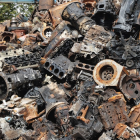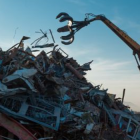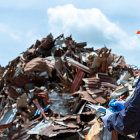From skyscrapers to bridges, scrap metal plays an essential role in building the modern infrastructure we rely on every day. Steel and aluminum recycled from old buildings, cars, and machinery are repurposed into the structural materials that form the foundation of our cities. In this blog, we will explore how scrap metal supports infrastructure development and why it is crucial for sustainable urbanization.
The Role of Scrap Metal in Construction
The construction industry is one of the largest consumers of recycled scrap metal, particularly steel. Steel is highly durable, versatile, and infinitely recyclable, making it a top choice for construction projects, including:
- Skyscrapers and High-Rises: Recycled steel is used to form the skeleton of modern high-rises, ensuring strength and durability.
- Bridges and Roads: The metal framework of bridges is often made from recycled steel, and scrap metal is also used in road construction.
- Residential Buildings: Scrap metal is used in the framing of homes, as well as in roofing and plumbing systems.
Environmental Benefits of Using Scrap Metal in Construction
- Reduction of Raw Material Extraction: Mining for iron ore and other metals is energy-intensive and harmful to the environment. By using scrap metal, construction projects can reduce the need for mining and conserve natural resources.
- Lower Energy Consumption: Producing steel from recycled scrap consumes less energy compared to making steel from virgin raw materials, helping construction companies lower their carbon footprint.
- Waste Reduction: By incorporating scrap metal, construction sites can drastically reduce waste sent to landfills. This also aligns with green building practices and LEED certification requirements.
Case Study: The Role of Recycled Steel in Building Sustainable Cities
Cities like New York and Tokyo have incorporated vast amounts of recycled metal into their infrastructures. In Tokyo, for instance, nearly 60% of the steel used in construction projects comes from recycled scrap, showing how urban centers can use scrap metal to promote sustainability.
Challenges in the Use of Scrap Metal for Infrastructure
Despite its benefits, using scrap metal in construction also presents challenges, such as:
- Supply Fluctuations: The availability of scrap metal can fluctuate due to economic downturns or global supply chain disruptions.
- Quality Control: Ensuring that scrap metal meets industry standards and is free from contaminants is essential to maintain structural integrity.
The Future of Scrap Metal in Infrastructure Development
As cities continue to expand, the demand for sustainable construction materials will rise. Scrap metal will continue to play a crucial role in modernizing infrastructure while reducing the environmental impact of urban development.
Conclusion
Scrap metal is the unsung hero behind modern infrastructure, contributing to the creation of buildings and bridges while promoting sustainable construction practices. As demand for eco-friendly materials grows, the importance of recycled metal will only increase, supporting the development of smarter, greener cities.






